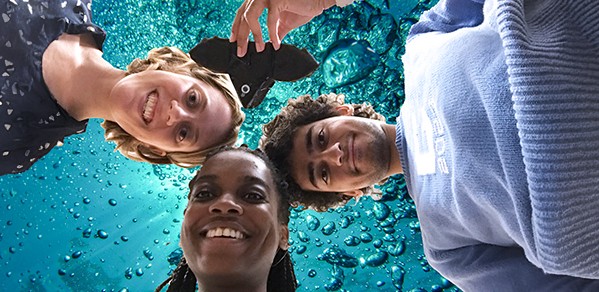
Three students studying for an MPhil in Machine Learning and Machine Intelligence were challenged to create a biologically inspired robot prototype for under $50. The result? A robotic fish with plenty of potential.
We were inspired to build Robot Fish as it was a chance to apply the theory we have been learning in the MPhil in a real project.
MPhil student Clare Heinbaugh
Sedinam Simpson, Clare Heinbaugh and Akshay Choudhry created the swimming robot – an extension of their robotics coursework project – in six weeks. Made from foam, duct tape and weighed down with screws to ensure partial submersion in water, the robot has a microprocessor for a ‘brain’, powered by a battery, and a light sensor that helps to control the speed of the servo motor. The more light there is the faster the servo motor drives the fish tail back and forth.
‘Robot Fish’, which is WiFi-enabled to allow experiments to be run remotely via a smartphone or laptop, received an honourable mention at the Soft Robotics on a Budget Challenge, hosted by the Democratization of Soft Robotics through Embodied Intelligence workshop.
Teams from around the world competed to come up with a simple, low-cost robot prototype that offers a solution to a specific real-life robotics problem.
Sedinam, Clare and Akshay say their Robot Fish has the potential to be used for underwater surveillance or excavation thanks to the inclusion of a fish eye that could, with further development, be replaced with a camera. The eye allows for tracking to create positional graphs.
“We were inspired to build Robot Fish as it was a chance to apply the theory we have been learning in the MPhil in a real project,” said Clare. “There are a lot of interesting hydrodynamic questions to be answered with robotic fish such as understanding how robotic actuators work in water.”
Sedinam added: “We enjoyed having fun during the process and the journey of creating something. Even a simple idea, like constructing a robotic fish in water, can be quite complicated to implement, especially with a physical product, which none of us had much experience with beforehand. We found the iterative process challenging. Some days we would spend hours in the lab and ‘fail’, but even in the failure we learnt what not to do the next time. On other days, things would go smoothly.”

